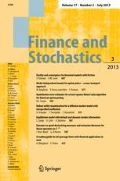Abstract
We investigate models with negative risk sums when the company invests its reserve into a risky asset whose price follows a geometric Brownian motion. Our main result is an exact asymptotic of the ruin probabilities for the case of exponentially distributed benefits. As in the case of non-life insurance with exponential claims, the ruin probabilities are either decreasing with a rate given by a power function (the case of small volatility) or equal to one identically (the case of large volatility). The result allows us to quantify the share of reserve to invest into such a risky asset to avoid a catastrophic outcome, namely the ruin with probability one. We address also the question of smoothness of the ruin probabilities as a function of the initial reserve for generally distributed jumps.
Similar content being viewed by others
References
Albrecher, H., Badescu, A., Landriault, D.: On the dual risk model with taxation. Insur. Math. Econ. 42, 1086–1094 (2008)
Asmussen, S., Albrecher, H.: Ruin Probabilities. World Scientific, Singapore (2010)
Avanzi, B., Gerber, H.U., Shiu, E.S.W.: Optimal dividends in the dual model. Insur. Math. Econ. 41, 111–123 (2007)
Bayraktar, E., Egami, M.: Optimizing venture capital investments in a jump diffusion model. Math. Methods Oper. Res. 67, 21–42 (2008)
Belkina, T.: Risky investments for insurers and sufficiency theorems for the survival probability. Markov Process. Relat. Fields 20, 505–525 (2014)
Belkina, T.A., Konyukhova, N.B., Kurochkin, S.V.: Singular boundary value problem for the integro-differential equation in an insurance model with stochastic premiums: analysis and numerical solution. Comput. Math. Math. Phys. 52, 1384–1416 (2012)
Belkina, T., Konyukhova, N., Kurochkin, S.: Singular problems for integro-differential equations in dynamic insurance models. In: Pinelas, S., et al. (eds.) Proc. Intern. Conf. on Differential and Difference Equations and Applications (in Honour of Prof. Ravi P. Agarval). Springer Proceedings in Mathematics & Statistics, vol. 47, pp. 27–44 (2013)
Borodin, A.N., Salminen, P.: Handbook of Brownian Motion—Facts and Formulae. Birkhäuser, Basel (2002)
Dufresne, D.: The distribution of a perpetuity, with application to risk theory and pension funding. Scand. Actuar. J., 39–79 (1990)
Fedoryuk, M.V.: Asymptotic Analysis: Linear Ordinary Differential Equations. Springer, Berlin (1993)
Feller, W.: An Introduction to Probability Theory and Its Applications, vol. 2. Wiley, New York (1996)
Frolova, A.G.: Some mathematical models of risk theory. All-Russian school-colloquium on stochastic methods in geometry and analysis. Abstracts, 117–118 (1994, unpublished)
Frolova, A., Kabanov, Yu., Pergamenshchikov, S.: In the insurance business risky investments are dangerous. Finance Stoch. 6, 227–235 (2002)
Gaier, J., Grandits, P.: Ruin probabilities and investment under interest force in the presence of regularly varying tails. Scand. Actuar. J., 256–278 (2004)
Goldie, C.M.: Implicit renewal theory and tails of solutions of random equations. Ann. Appl. Probab. 1, 126–166 (1991)
Grandell, I.: Aspects of Risk Theory. Springer, Berlin (1990)
Grandits, P.: A Karamata-type theorem and ruin probabilities for an insurer investing proportionally in the stock market. Insur. Math. Econ. 34, 297–305 (2004)
Harrison, M.: Ruin problems with compounding assets. Stoch. Process. Appl. 5, 67–79 (1977)
Hult, H., Lindskog, F.: Ruin probabilities under general investments and heavy-tailed claims. Finance Stoch. 15, 243–265 (2011)
Kalashnikov, V., Norberg, R.: Ruin probability under random interest rate, 2. Preprint, Lab. of Actuarial Math., University of Copenhagen, Copenhagen (1999)
Kalashnikov, V., Norberg, R.: Power tailed ruin probabilities in the presence of risky investments. Stoch. Process. Appl. 98, 211–228 (2002)
Matsumoto, H., Yor, M.: Exponential functionals of Brownian motion, I: probability laws at fixed time. Probab. Surv. 2, 312–347 (2005)
Norberg, R.: Ruin problems with assets and liabilities of diffusion type. Stoch. Process. Appl. 81, 255–269 (1999)
Nyrhinen, H.: On the ruin probabilities in a general economic environment. Stoch. Process. Appl. 83, 319–330 (1999)
Nyrhinen, H.: Finite and infinite time ruin probabilities in a stochastic economic environment. Stoch. Process. Appl. 92, 265–285 (2001)
Paulsen, J.: Sharp conditions for certain ruin in a risk process with stochastic return on investments. Stoch. Process. Appl. 75, 135–148 (1998)
Paulsen, J., Gjessing, H.K.: Ruin theory with stochastic return on investments. Adv. Appl. Probab. 29, 965–985 (1997)
Pergamenshchikov, S., Zeitouni, O.: Ruin probability in the presence of risky investments. Stoch. Process. Appl. 116, 267–278 (2006)
Pergamenshchikov, S.: Erratum to: “Ruin probability in the presence of risky investments” [Stoch. Process. Appl. 116, 267–278 (2006)]. Stoch. Process. Appl. 119, 305–306 (2009)
Revuz, D., Yor, M.: Continuous Martingales and Brownian Motion, 3rd edn. Springer, Berlin (1999)
Saxén, T.: On the probability of ruin in the collective risk theory for insurance enterprises with only negative risk sums. Scand. Actuar. J., 199–228 (1948)
Wang, G., Wu, R.: Distributions for the risk process with a stochastic return on investments. Stoch. Process. Appl. 95, 329–341 (2001)
Yor, M.: On some exponential functionals of Brownian motion. Adv. Appl. Probab. 24, 509–531 (1992)
Acknowledgements
The research is funded by the grant of the Government of Russian Federation no. 14.A12.31.0007. The second author is partially supported by International Laboratory of Statistics of Stochastic Processes and Quantitative Finance of National Research Tomsk State University.
Author information
Authors and Affiliations
Corresponding author
Additional information
Dedicated to the memory of Marc Yor.
Appendix: Ergodic theorem for an autoregression with random coefficients
Appendix: Ergodic theorem for an autoregression with random coefficients
Let \((a_{n},b_{n})_{n\ge1}\) be an i.i.d. sequence of random variables in \({\mathbb {R}}^{2}\) and \(x_{0}\) an arbitrary constant. Define the sequence \((x_{n})\) recursively by the formula
Proposition A.1
Assume that there exists \(\delta\in(0,1]\) such that
Then for any bounded uniformly continuous function \(f\),
where
The proof is given in [28].
Rights and permissions
About this article
Cite this article
Kabanov, Y., Pergamenshchikov, S. In the insurance business risky investments are dangerous: the case of negative risk sums. Finance Stoch 20, 355–379 (2016). https://doi.org/10.1007/s00780-016-0292-4
Received:
Accepted:
Published:
Issue Date:
DOI: https://doi.org/10.1007/s00780-016-0292-4
Keywords
- Negative risk sums models
- Financial markets
- Smoothness of the exit probability
- Exponential functional of a Brownian motion
- Autoregression with random coefficients


